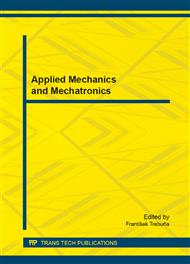[1]
TAKALA,J., MALINDŽÁK,D., STRAKA, M.: Manufacturing strategy: Applying the logistics models / - Vaasa: Vaasan yliopisto - University of Vaasa, - 2007. - 206 p. - ISBN 978-952-476-179-6.
Google Scholar
[2]
ROSOVÁ, Andrea. - PRIBULOVÁ, Alena. - BARICOVÁ, Dana. - FEDORKO, Gabriel.: Dekompozícia logistického systému podniku systémovou analýzou, Logistický monitor. Jún 2012 (2012), s. 1-15. - ISSN 1336-5851.
Google Scholar
[3]
FEDORKO, Gabriel., MALINDŽÁK, Dušan., TALIAN, Juraj.: Analýza procesu betonáže na stavbe pomocou diskrétneho simulačného modelu, - 2010. - 1 elektronický optický disk (CD-ROM). In: Logistika v teorii a praxi : sborník příspěvků z mezinárodní vědecké konference vydaný v rámci řešení projektu : Uherské Hradiště, 2010. - Uherské Hradiště : Ústav logistiky, 2010 P. 3-10. - ISBN 978-80-7318-939-6.
Google Scholar
[4]
SAAKSVUORI, A., IMMONEN,A.: Product Lifecycle Management, ISBN 987-3-540-78172-1.
Google Scholar
[5]
STARK, J.: Product Lifecycle Management, 21 st Century Paradigm for Product Realisation, ISBN 978-0-85729-546-0.
Google Scholar
[6]
GREGOR, M., DILSKÝ, S., PALAJOVÁ, S., FIGA, Š.: Operačný manažment II., Návody na cvičenia. Žilina: CEIT, a. s., 2012. 87 s. ISBN 978-80-970440-3-9.
Google Scholar
[7]
BANGSOW, S.: Manufacturing Simulation with Plant Simulation and SimTalk. Berlin Heidelberg: Springer, 2010. 297 s. ISBN 978-3-642-05073-2.
Google Scholar
[8]
JANEKOVÁ, J., JANEK, J., Možnosti zvyšovania efektívnosti v prúdovej výrobe. In: Transfer inovácií. 9/2006, Košice, TU-SjF, 2006 S. 163-166.
Google Scholar
[9]
LENORT, R., STAŠ, D., SAMOLEJOVÁ, A.: Capacity planning in operations producing heavy plate cut shapes, (2009) Metalurgija 48 (3) PP. 209 - 211.
Google Scholar
[10]
BESTA, P., SAMOLEJOVÁ, A., JANOVSKÁ, K., LAMPA, M., LENORT, R. Evaluation of benefits resulting from innovation of input raw materials dosing process in sintering. Metalurgija, October-December 2012, Vol. 51, No. 4, pp.457-460.
Google Scholar
[11]
Kudrna, J., Miller, A., Edl, M., Methods of industrial engineering in network organizations. In Creating Global Competitive economies - A 360-degree Approach., International Business Information Management Association (IBIMA), 2011. s. 2037-(2042).
Google Scholar
[12]
Šimlová, M., Kroták, S., Edl, M., Product life cycles and Ergonomics. In Innovation Vision 2020. Barcelona: IBIMA Publishing, 2012. s. 430-437.
Google Scholar
[13]
Kłos S., Evaluation methodology of ERP system implementation in manufacturing enterprises, Oficyna Wydaw. Uniwersytetu Zielonogórskiego, (2010).
Google Scholar
[14]
S. Saniuk, A. Saniuk, Rapid prototyping of constraint-based production flows in outsourcing, Advanced Materials Research, Vol. 44-46, 2008, p.355-360s.
DOI: 10.4028/www.scientific.net/amr.44-46.355
Google Scholar


